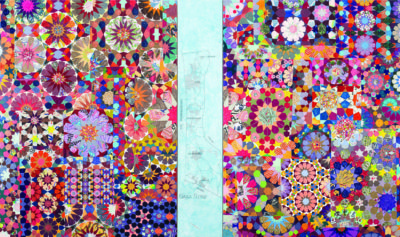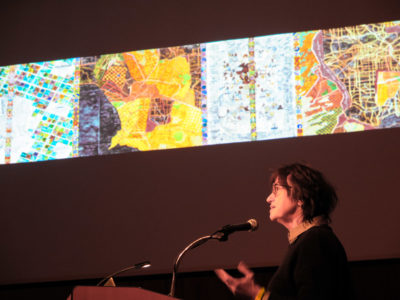Joyce Kozloff doesn’t need a man to explain the world to her. On March 8, she visited FIT to share her work and philosophy.
After living in Mexico in the early ’70s and traveling in Morocco and Turkey, Kozloff resented the way the European male canon excluded decorative arts—often the domain of women or non-Western peoples. A co-founder of both the 1970s Pattern and Decoration movement and the Heresies feminist art collective, Kozloff started her career painting decorative art motifs on large canvases to challenge the definition of “high art.”

Her 1978 installation An Interior Decorated pushed this concept further: instead of painting canvases to be hung on the walls, she installed the art directly into the gallery space, hand-painting tile pilasters, decorating the walls with silk-screened textile panels and lithographs on Chinese silk paper, and building a functional floor composed of hand-painted tiles. Critic Carrie Rickey wrote, “An Interior Decorated is where painting meets architecture, where art meets craft, where personal commitment meets public art.”
In the 1980s, Kozloff moved her work out of the gallery into site-specific public installations using many of the same glass and ceramic mosaic techniques from her earlier pieces. For example, she created her 1985 installation in Suburban Station, Philadelphia, titled Galla Placidia in Philadelphia, using Byzantine mosaic techniques but replaced the Christian saints with local hero William Penn, playing with the definition of icons and saints, Western art, and local history.
Collaborating with city planners on her public art spurred her lasting interest in cartography. Since the 1990s, Kozloff has worked with maps as a device for examining history, geography, popular art, and culture. Her work Los Angeles Becoming Mexico City Becoming Los Angeles (1993) examines two places she has lived, Mexico City and Los Angeles, by layering historical and current maps that illustrate the expanding borders of the U.S., as well as patterns and motifs from pre-Columbian artwork of the regions. The results are “places that don’t exist with elements of places that do exist.” Her series Knowledge comprised 65 frescoes and six tabletop globes that drew on inaccurate maps from the Age of Discovery, 1400-1700, to focus on the arbitrary nature of what is known, expanding on her investigation into accuracy and inaccuracy, reality and imagination.

These themes resurface in her print series Social Studies (2011). Working from vintage French classroom maps, she collaged in images of historic and current conflict zones, slave trade and labor struggles, pop culture and propaganda, extinct and endangered wildlife, and contemporary maps of the areas. When asked how these map-based works relate to her earlier feminist pieces, she described her annoyance over depictions of the Renaissance-era cartographers pointing at tiny globes, as if they were a “literal, visual representation of men explaining things to me. That is what I have always been fighting against.”
The talk was sponsored by ARTSpeak, an interdisciplinary program presented by the departments of Fine Arts and History of Art.
